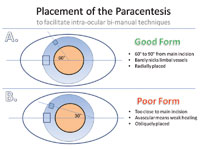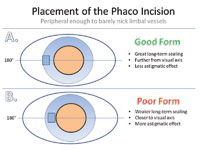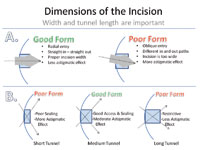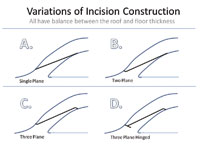Corneal phaco incisions require careful construction for successful cataract surgery
In the next series of columns we will go through some of the basic concepts behind each of the steps of cataract surgery. Some of these techniques, such as how to make corneal incisions, apply to many different types of ocular surgery, whereas others, such as capsulorrhexis creation, are specific to phaco surgery.
In cataract surgery, the phaco incision is of critical importance: It allows intraocular access, influences the fluidic balance, affects the astigmatism of the eye and seals to maintain intraocular asepsis. This column focuses on corneal incisions.
Paracentesis creation
Creating the paracentesis is thought of as just a stab incision; however, it is much more. A completely avascular corneal incision never heals to the original strength of the cornea, so an effort should be made to barely nick the limbal vessels. This makes for better healing with stronger long-term stability and integrity. The paracentesis incision should typically be made radially, toward the center of the eye, except when access to a specific part of the eye would be better with an oblique incision. The paracentesis should be approximately 60° to 90° from the main phaco incision to facilitate intraocular bimanual techniques. If the paracentesis is too close or too far from the main incision, it can make these techniques more awkward (Figure 1).

Figure 1. Paracentesis incisions should have specific characteristics (A) and not others (B).
Images: Devgan U
Corneal incision form, location
The size and form of the corneal phaco incisions are critical to give intraocular access and to determine the fluidic balance during phacoemulsification. Like the paracentesis, the main corneal incision should barely nick limbal vessels to ensure long-term sealing (Figure 2). A purely avascular corneal incision such as a phaco incision, a LASIK flap or a penetrating keratoplasty interface can be opened years later with relatively blunt instruments because it does not achieve its original strength.
The incision should be made further from the visual axis to be more astigmatically neutral. Incisions that encroach upon the visual axis can induce larger degrees of astigmatism; therefore, a temporal incision, which is further from the visual axis than a superior incision, is preferred in most cases. Some surgeons prefer to use the relaxing effect of the phaco incision to neutralize pre-existing corneal astigmatism by placing the incision on the steep corneal axis.

Figure 2. The corneal phaco incision should barely nick the limbal vessels (A). If it is too close to the visual axis (B) it can induce significant astigmatism.

Figure 3. A good, symmetric incision has an equal thickness of the roof and floor (A), whereas a poorly balanced incision has a chevron appearance (B).
The roof and floor of the phaco incision should be symmetric and approximately even to ensure the best sealing. An incision with good form is seen as a square when viewed through the surgical microscope. A common mistake in incision construction it to have a shallow roof and then abruptly change the angle of the blade downward to enter the anterior chamber. This results in an asymmetric incision with a thicker floor than roof, and it appears as a chevron sign when seen through the operating microscope (Figure 3).
Incision dimension
The dimensions of the incision — both width and tunnel length — are important for its function (Figure 4). A wide incision allows too much egress of fluid, which can make the outflow higher than the fluid inflow, leading to surge and an increased risk of posterior capsular rupture during surgery. Making the incision radial with a straight-in, straight-out approach creates an incision width exactly the same as the blade. If the blade enters the eye from an oblique angle with a different in-and-out path, the incision will be wider than the blade and prone to leakage.
Over the past decade, we have seen phaco incisions drop in size from 3.5 mm to less than 2 mm wide. Regardless of the size of the phaco needle and probe, the key is to match the width of the phaco incision to your current machine setup. An incision that is too narrow will inhibit the movement of the phaco probe in the eye and may inhibit fluid flow around the phaco needle. This fluid flow is used to cool the phaco needle, and when it is limited there is an increased risk of a phaco wound burn from the frictional heat created during ultrasonic energy delivery.

Figure 4. The corneal phaco incision should have the correct width (A) and tunnel length (B) for best results.

Figure 5. As long as the incision is balanced, a single (A), dual (B) or three-plane (C) incision can be successful. The Langerman hinge design (D) may be more resistant to external forces applied to the globe.
Tunnel length
The tunnel length of the incision determines the surface area between the two interfaces, with more surface area tending to produce better sealing and integrity of the wound. However, too long of a tunnel can lead to oar-locking of instruments in the incision and restrict movement and access to parts of the anterior chamber, particularly the sub-incisional area.
A short tunnel length, while allowing for easy access to the entire anterior chamber, tends not to seal as well and may induce a larger degree of astigmatic flattening. The ideal incision tends to be approximately square, with the tunnel length being about the same as the width for incisions of 2.5 mm or smaller. For wider incisions, keeping the tunnel length at about 2.5 mm allows for good access to the anterior chamber, but a suture may be required to appropriately close a larger wound.
Variations
These fundamentals serve as the basis for constructing corneal incisions for cataract surgery, but there are other variations as well. Incisions can be made with one, two or three planes, or with a hinge integrated into the design. We can use steel knives, diamond blades or even femtosecond lasers to make the incision. All of these variations have a balance between the roof and floor thickness and incorporate the concepts of good form (Figure 5).
For more information:
- Uday Devgan, MD, is in private practice at Devgan Eye Surgery in Los Angeles and Beverly Hills. He can be reached at 11600 Wilshire Blvd., Suite 200, Los Angeles, CA 90025; 800-337-1969; email: devgan@gmail.com; website: www.DevganEye.com.
- Disclosure: No products or companies are mentioned that would require financial disclosure.
